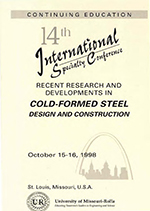Session Dates
15 Oct 1998
Abstract
In a highly competitive and aggressive construction market, designers are always looking for new, proven ways to design safe, economical building structures. This is even more relevant in tract residential construction where a few dollars saved on one detail can affect who is awarded a project. In residential construction, a complete load bearing light gauge steel (LGS) system is now somewhat commonplace in the United States. Architects and engineers who once designed almost exclusively with other conventional materials are now consider LGS as an alternative. Although, it is feasible to make a direct substitution of LGS for conventional wood framing, the response of the system (and its components) may not be similar. Thus, designers who are not familiar with LGS should make every attempt possible to become aware of the statistical variability of computed values determined from design guidelines. In this paper, a few of the important design criteria related to lateral load design are discussed. Conventional light frame construction using LGS is similar to wood and in some cases one can make a direct "stick-for-stick" replacement of one material for the next. Where light gauge steel differs from wood framing is in the response of members to induced forces, and in some cases, flexibility and details of physical application/ construction. One area worthy of consideration (post 1994 Northridge earthquake) is the lateral load response of LGS construction in high seismic zones, particularly the vertical lateral support system. For wood framed construction, vertical lateral resistance is typically provided by wood structural panels attached to the frame. In light gauge steel construction, the designer has at least four options for providing lateral resistance: wood structural panels, flatstrap X-bracing, metal sheathing, or a braced system. These systems can be generic or one of the many proprietary systems available in the residential market today.
Department(s)
Civil, Architectural and Environmental Engineering
Research Center/Lab(s)
Wei-Wen Yu Center for Cold-Formed Steel Structures
Meeting Name
14th International Specialty Conference on Cold-Formed Steel Structures
Publisher
University of Missouri--Rolla
Document Version
Final Version
Rights
© 1998 University of Missouri--Rolla, All rights reserved.
Document Type
Article - Conference proceedings
File Type
text
Language
English
Recommended Citation
Serrette, Reynaud, "Seismic Design of Light Gauge Steel Structures: a Discussion" (1998). CCFSS Proceedings of International Specialty Conference on Cold-Formed Steel Structures (1971 - 2018). 2.
https://scholarsmine.mst.edu/isccss/14iccfsss/14iccfsss-session6/2
Seismic Design of Light Gauge Steel Structures: a Discussion
In a highly competitive and aggressive construction market, designers are always looking for new, proven ways to design safe, economical building structures. This is even more relevant in tract residential construction where a few dollars saved on one detail can affect who is awarded a project. In residential construction, a complete load bearing light gauge steel (LGS) system is now somewhat commonplace in the United States. Architects and engineers who once designed almost exclusively with other conventional materials are now consider LGS as an alternative. Although, it is feasible to make a direct substitution of LGS for conventional wood framing, the response of the system (and its components) may not be similar. Thus, designers who are not familiar with LGS should make every attempt possible to become aware of the statistical variability of computed values determined from design guidelines. In this paper, a few of the important design criteria related to lateral load design are discussed. Conventional light frame construction using LGS is similar to wood and in some cases one can make a direct "stick-for-stick" replacement of one material for the next. Where light gauge steel differs from wood framing is in the response of members to induced forces, and in some cases, flexibility and details of physical application/ construction. One area worthy of consideration (post 1994 Northridge earthquake) is the lateral load response of LGS construction in high seismic zones, particularly the vertical lateral support system. For wood framed construction, vertical lateral resistance is typically provided by wood structural panels attached to the frame. In light gauge steel construction, the designer has at least four options for providing lateral resistance: wood structural panels, flatstrap X-bracing, metal sheathing, or a braced system. These systems can be generic or one of the many proprietary systems available in the residential market today.



